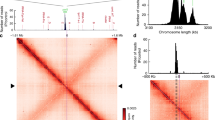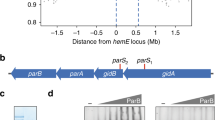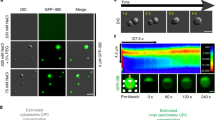Abstract
Until recently, a dedicated mitotic apparatus that segregates newly replicated chromosomes into daughter cells was believed to be unique to eukaryotic cells. Here we demonstrate that the bacterium Caulobacter crescentus segregates its chromosome using a partitioning (Par) apparatus that has surprising similarities to eukaryotic spindles. We show that the C. crescentus ATPase ParA forms linear polymers in vitro and assembles into a narrow linear structure in vivo. The centromere-binding protein ParB binds to and destabilizes ParA structures in vitro. We propose that this ParB-stimulated ParA depolymerization activity moves the centromere to the opposite cell pole through a burnt bridge Brownian ratchet mechanism. Finally, we identify the pole-specific TipN protein1,2 as a new component of the Par system that is required to maintain the directionality of DNA transfer towards the new cell pole. Our results elucidate a bacterial chromosome segregation mechanism that features basic operating principles similar to eukaryotic mitotic machines, including a multivalent protein complex at the centromere that stimulates the dynamic disassembly of polymers to move chromosomes into daughter compartments.
This is a preview of subscription content, access via your institution
Access options
Subscribe to this journal
Receive 12 print issues and online access
$209.00 per year
only $17.42 per issue
Buy this article
- Purchase on Springer Link
- Instant access to full article PDF
Prices may be subject to local taxes which are calculated during checkout





Similar content being viewed by others
References
Lam, H., Schofield, W. B. & Jacobs-Wagner, C. A landmark protein essential for establishing and perpetuating the polarity of a bacterial cell. Cell 124, 1011–1023 (2006).
Huitema, E., Pritchard, S., Matteson, D., Radhakrishnan, S. K. & Viollier, P. H. Bacterial birth scar proteins mark future flagellum assembly site. Cell 124, 1025–1037 (2006).
Gerdes, K., Moller-Jensen, J. & Bugge Jensen, R. Plasmid and chromosome partitioning: surprises from phylogeny. Mol. Microbiol. 37, 455–466 (2000).
Mohl, D. A., Easter, J., Jr & Gober, J. W. The chromosome partitioning protein, ParB, is required for cytokinesis in Caulobacter crescentus. Mol. Microbiol. 42, 741–755 (2001).
Mohl, D. A. & Gober, J. W. Cell cycle-dependent polar localization of chromosome partitioning proteins in Caulobacter crescentus. Cell 88, 675–684 (1997).
Toro, E., Hong, S. H., McAdams, H. H. & Shapiro, L. Caulobacter requires a dedicated mechanism to initiate chromosome segregation. Proc. Natl Acad. Sci. USA 105, 15435–15440 (2008).
Bowman, G. R. et al. Caulobacter PopZ forms a polar subdomain dictating sequential changes in pole composition and function. Mol. Microbiol. 76, 173–189.
Bowman G. R. et al. Polymeric protein anchors the chromosomal origin/ParB complex at a bacterial cell pole. Cell 134, 945–955 (2008).
Ebersbach G, B. A., Jensen GJ, Jacobs-Wagner C A self-associating protein critical for chromosome attachment, division, and polar organization in Caulobacter. Cell 134, 956–968 (2008).
Lim, G. E., Derman, A. I. & Pogliano, J. Bacterial DNA segregation by dynamic SopA polymers. Proc. Natl Acad. Sci. USA 102, 17658–17663 (2005).
Bouet, J. Y., Ah-Seng, Y., Benmeradi, N. & Lane, D. Polymerization of SopA partition ATPase: regulation by DNA binding and SopB. Mol. Microbiol. 63, 468–481 (2007).
Fogel, M. A. & Waldor, M. K. A dynamic, mitotic-like mechanism for bacterial chromosome segregation. Genes Dev. 20, 3269–3282 (2006).
Hatano, T., Yamaichi, Y. & Niki, H. Oscillating focus of SopA associated with filamentous structure guides partitioning of F plasmid. Mol. Microbiol. 64, 1198–1213 (2007).
Leonard, T. A., Moller-Jensen, J. & Lowe, J. Towards understanding the molecular basis of bacterial DNA segregation. Philos. Trans. R. Soc. Lond. B. Biol. Sci. 360, 523–535 (2005).
Ringgaard, S., van Zon, J., Howard, M. & Gerdes, K. Movement and equipositioning of plasmids by ParA filament disassembly. Proc. Natl Acad. Sci. USA 106, 19369–19374 (2009).
Barilla, D., Rosenberg, M. F., Nobbmann, U. & Hayes, F. Bacterial DNA segregation dynamics mediated by the polymerizing protein ParF. EMBO J. 24, 1453–1464 (2005).
Ebersbach, G. et al. Regular cellular distribution of plasmids by oscillating and filament-forming ParA ATPase of plasmid pB171. Mol. Microbiol. 61, 1428–1442 (2006).
Leonard, T. A., Butler, P. J. & Lowe, J. Bacterial chromosome segregation: structure and DNA binding of the Soj dimmer — a conserved biological switch. EMBO J. 24, 270–282 (2005).
Pratto, F. et al. Streptococcus pyogenes pSM19035 requires dynamic assembly of ATP-bound ParA and ParB on parS DNA during plasmid segregation. Nucleic Acids Res. 36, 3676–3689 (2008).
Batt, S. M., Bingle, L. E., Dafforn, T. R. & Thomas, C. M. Bacterial genome partitioning: N-terminal domain of IncC protein encoded by broad-host-range plasmid RK2 modulates oligomerisation and DNA binding. J. Mol. Biol. 385, 1361–1374 (2009).
Ebersbach, G. & Gerdes, K. The double par locus of virulence factor pB171: DNA segregation is correlated with oscillation of ParA. Proc. Natl Acad. Sci. USA 98, 15078–15083 (2001).
Ebersbach, G. & Gerdes, K. Bacterial mitosis: partitioning protein ParA oscillates in spiral-shaped structures and positions plasmids at mid-cell. Mol. Microbiol. 52, 385–398 (2004).
Quisel, J. D., Lin, D. C. & Grossman, A. D. Control of development by altered localization of a transcription factor in B. subtilis. Mol. Cell 4, 665–672 (1999).
Marston, A. L. & Errington, J. Dynamic movement of the ParA-like Soj protein of B. subtilis and its dual role in nucleoid organization and developmental regulation. Mol. Cell 4, 673–682 (1999).
Castaing, J. P., Bouet, J. Y. & Lane, D. F plasmid partition depends on interaction of SopA with non-specific DNA. Mol. Microbiol. 70, 1000–1011 (2008).
Barilla, D., Carmelo, E. & Hayes, F. The tail of the ParG DNA segregation protein remodels ParF polymers and enhances ATP hydrolysis via an arginine finger-like motif. Proc. Natl Acad. Sci. USA 104, 1811–1816 (2007).
Easter, J., Jr & Gober, J. W. ParB-stimulated nucleotide exchange regulates a switch in functionally distinct ParA activities. Mol. Cell 10, 427–434 (2002).
Fung, E., Bouet, J. Y. & Funnell, B. E. Probing the ATP-binding site of P1 ParA: partition and repression have different requirements for ATP binding and hydrolysis. EMBO J. 20, 4901–4911 (2001).
Murray, H. & Errington, J. Dynamic control of the DNA replication initiation protein DnaA by Soj/ParA. Cell 135, 74–84 (2008).
Hester, C. M. & Lutkenhaus, J. Soj (ParA) DNA binding is mediated by conserved arginines and is essential for plasmid segregation. Proc. Natl Acad. Sci. USA 104, 20326–20331 (2007).
Thanbichler, M. & Shapiro, L. MipZ, a spatial regulator coordinating chromosome segregation with cell division in Caulobacter. Cell 126, 147–162 (2006).
Gruber, S. & Errington, J. Recruitment of condensin to replication origin regions by ParB/SpoOJ promotes chromosome segregation in B. subtilis. Cell 137, 685–696 (2009).
Charles, M., Perez, M., Kobil, J. H. & Goldberg, M. B. Polar targeting of Shigella virulence factor IcsA in Enterobacteriacae and Vibrio. Proc. Natl Acad. Sci. USA 98, 9871–9876 (2001).
Breier, A. M. & Grossman, A. D. Whole-genome analysis of the chromosome partitioning and sporulation protein Spo0J (ParB) reveals spreading and origin-distal sites on the Bacillus subtilis chromosome. Mol. Microbiol. 64, 703–718 (2007).
Rodionov, O., Lobocka, M. & Yarmolinsky, M. Silencing of genes flanking the P1 plasmid centromere. Science 283, 546–549 (1999).
Fiebig, A., Keren, K. & Theriot, J. A. Fine-scale time-lapse analysis of the biphasic, dynamic behaviour of the two Vibrio cholerae chromosomes. Mol. Microbiol. 60, 1164–1178 (2006).
Viollier, P. H. et al. Rapid and sequential movement of individual chromosomal loci to specific subcellular locations during bacterial DNA replication. Proc. Natl Acad. Sci. USA 101, 9257–9262 (2004).
Tanaka, T. U. & Desai, A. Kinetochore-microtubule interactions: the means to the end. Curr. Opin. Cell Biol. 20, 53–63 (2008).
Deich, J., Judd, E. M., McAdams, H. H. & Moerner, W. E. Visualization of the movement of single histidine kinase molecules in live Caulobacter cells. Proc. Natl Acad. Sci. USA 101, 15921–15926 (2004).
Biteen, J. S. et al. Super-resolution imaging in live Caulobacter crescentus cells using photo-switchable EYFP. Nature Methods (2008).
Thanbichler, M., Iniesta, A.A., Shapiro, L. A comprehensive set of plasmids for vanillate- and xylose-inducible gene expression in Caulobacter crescentus. Nucleic Acids Res. 35, e137 (2007).
Acknowledgements
We thank Jimmy Blair for assistance with modelling of ParA mutants, and critical reading of the manuscript; and Grant Bowman, Erin Goley and Julie Biteen for technical advice. We thank Jian Zhu and Thomas Earnest for providing purified 6His–ParB. This work is supported by National Institutes of Health grants R01 GM51426 R24 and GM073011-04d to L.S., NIH/NIGMS fellowship F32GM088966-1 to J.P., NIH/NIGMS award R01GM086196-2 to W.E.M., the Smith Stanford Graduate Fellowship to E.T., and a Helen Hay Whitney postdoctoral fellowship to E.G. This work was also supported by the Director, Office of Science, Office of Biological and Environmental Research, of the U.S. Department of Energy under contract no. DE-AC02-05CH11231.
Author information
Authors and Affiliations
Contributions
J.P., S.L., W.E.M. and L.S. designed the research; J.P. performed C. crescentus genetic, epifluorescence microscopy and biochemical experiments; S.L. performed single molecule imaging and data analysis; E.G. purified native ParA and performed ParA light-scattering experiments; E.T. designed ParA/DNA SPR experiments and performed time-lapse microscopy experiments on ΔtipN strains; M.E. performed SPR experiments and analysis; L.C. performed ParA negative-stain electron microscopy imaging; W.E.M. and L.S. supervised the study; J.P., S.L., W.E.M. and L.S. wrote the paper.
Corresponding author
Ethics declarations
Competing interests
The authors declare no competing financial interests.
Supplementary information
Supplementary Information
Supplementary Information (PDF 1724 kb)
Rights and permissions
About this article
Cite this article
Ptacin, J., Lee, S., Garner, E. et al. A spindle-like apparatus guides bacterial chromosome segregation. Nat Cell Biol 12, 791–798 (2010). https://doi.org/10.1038/ncb2083
Received:
Accepted:
Published:
Issue Date:
DOI: https://doi.org/10.1038/ncb2083
This article is cited by
-
Mechanochemical feedback loop drives persistent motion of liposomes
Nature Physics (2023)
-
Stable inheritance of Sinorhizobium meliloti cell growth polarity requires an FtsN-like protein and an amidase
Nature Communications (2021)
-
Development of recombinant human granulocyte colony-stimulating factor (nartograstim) production process in Escherichia coli compatible with industrial scale and with no antibiotics in the culture medium
Applied Microbiology and Biotechnology (2021)
-
Geometric principles underlying the proliferation of a model cell system
Nature Communications (2020)
-
Nucleoid-mediated positioning and transport in bacteria
Current Genetics (2020)



